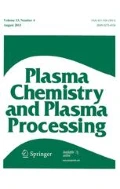Correction to: Plasma Chem Plasma Process (2018) 38:223–245 https://doi.org/10.1007/s11090-017-9852-4
The original version of this article unfortunately contained a mistake in the “Deposition of Stannane (DOS) Chamber” section. It should read as follows: “The synthesis of stannane was accidentally stated to follow an earlier version of the procedure that was more similar to that published by Norman [22]. This procedure was eventually modified by replacing the diethyl ether solvent with a high-boiling solvent mixture so that trap-to-trap distillations could be omitted without contamination of the final product. A 500-mL three-neck flask was equipped with a magnetic stir bar, and its joints were fitted with a dry ice condenser, a connection to a Schlenk line, and a rubber septum. The hose adapter on the top of the dry ice condenser was connected through three U-shaped traps in sequence to the Schlenk line. The traps were equipped with stopcocks on both their inlets and outlets. The entire system was evacuated and refilled with N2 three times. The traps were evacuated and were isolated by closing their stopcocks. The flask was charged with LiAlH4 (2.16 g, 57 mmol), 1,2-dimethoxyethane (30 mL), and dibutyl ether (30 mL). We found that this solvent mixture worked far better than either solvent alone. The mixture was cooled to − 196 °C, the condenser was charged with dry ice, the trap nearest to the flask was cooled to − 95 °C (toluene slush), and the remaining two traps were cooled to − 196 °C. SnCl4 (6.0 mL, 51 mmol) was added slowly to the flask through the septum by means of a syringe equipped with a Teflon needle. The septum was replaced with a glass stopper, and the flask was evacuated. The flask was then isolated from the Schlenk line, and the reaction mixture was slowly warmed to − 50 °C to allow the solvent to melt. The stopcocks on the traps were then opened except for the stopcock between the last trap and the Schlenk line, which was closed most of the time but opened every 5 min or so as to remove the generated H2. The reaction mixture was slowly warmed to − 30 °C and was kept at this temperature for 2 h. At the end of this period, the material in the − 95 °C trap (mostly solvent) was discarded. The stannane in the − 196 °C traps was combined and stored in liquid nitrogen until used. NMR studies show that only traces of solvent (< 0.1%) are present in the stannane product”.
Author information
Authors and Affiliations
Corresponding authors
Rights and permissions
About this article
Cite this article
Elg, D.T., Panici, G.A., Liu, S. et al. Correction to: Removal of Tin from Extreme Ultraviolet Collector Optics by In-Situ Hydrogen Plasma Etching. Plasma Chem Plasma Process 38, 917–918 (2018). https://doi.org/10.1007/s11090-018-9882-6
Published:
Issue Date:
DOI: https://doi.org/10.1007/s11090-018-9882-6

